
Scroll for additional information
These unfinished plaster models found in Walter Przybylek’s studio show the hand work involved with incising and sculpting designs out of plaster blanks. Working with such forms allowed craftsmen to create new and reproducible designs for existing product shapes.
No evidence survives to identify these pieces with specific projects, but most of this set may represent unfinished lamp and lantern components.
While specific companies for which these pieces might have been made are unknown, a similar process could have been involved in the creation of product lines such as McKee Prescut and Imperial Nucut glassware.
These pieces have been donated to the collection of the Senator John Heinz History Center in Pittsburgh, Pennsylvania.
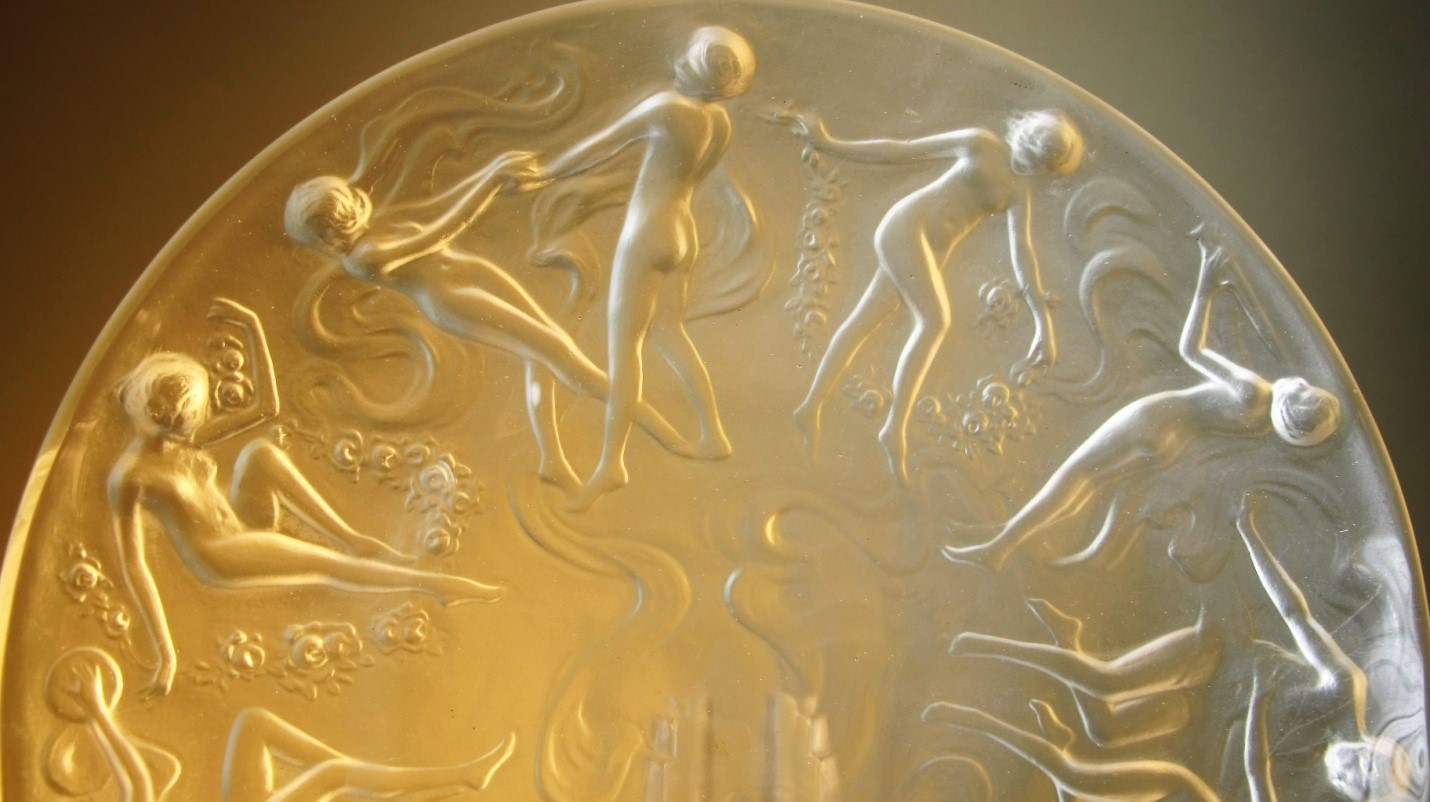
Scroll for additional information
Primarily designed by Reuben Haley, this line of figural plates and vases started as part of Consolidated’s Martelé line.
The Great Depression shaped the story of this line. Introduced in 1926 for Consolidated’s Martelé art glass collection, the Dancing Nymph was transferred to Phoenix Glass after Consolidated temporarily closed in 1932. (Haley owned the rights to his designs.) After Consolidated resumed production, both companies produced versions of the motif, although they were totally separate entities.
From a modeling and design perspective, the base nymph motif could be adapted to varying sizes of new glassware using a pantograph moulding machine. Duplicated designs could be reduced or enlarged as needed. Individual models, made for each nymph within the larger pattern, could be refined, transferred, and incorporated into the master design for the finished piece.
A surviving set of plaster mold components created by Walter Przybylek for one reclining nymph illustrates this unseen part of the larger process. The positive side of the mold shows the hand detailing that went into clarifying and redefining elements of the design. This is believed to be a one-of-a-kind surviving artifact.
These pieces have been donated to the collection of the Senator John Heinz History Center in Pittsburgh, Pennsylvania.

Scroll for additional information
Featuring distinctive “harsh and strong triangular and rhomboidal planes”, the Ruba Rombic line cemented Reuben Haley’s reputation as one of the most prominent and leading glass designers in the U.S.
By Walter’s recollection, creation of the Ruba Rhombic design was, to a certain degree, accidental in nature. Reuben and his team would work all day at their potter’s wheels creating and then refining plaster models. In order to remove the plaster from their hands, team members would simply wipe their hands against the legs of their workbenches. By the end of the day, there would be a large blob of plaster on each bench leg, which was knocked off and swept up during the evening cleanup.
Walter recalled Reuben Haley standing in the design shop one evening and picking up one of the discarded plaster blobs off the shop floor. Reuben began to randomly chop away at the plaster with a chisel, and after a few minutes said “What do you think, could we make something like this?” Reuben then told Walt and the rest of the team to come up with some drawings of potential designs incorporating this distinctive angular design. From this seemingly random act came the preliminary designs for Ruba Rombic. Reuben and his design team later completed the sketches and presented the idea to Consolidated executives, and one of the most iconic designs of Art Deco glass was born.
Today, examples of Ruba Rombic glass are housed in prominent glass and art museums throughout the U.S. and world, including the Brooklyn Museum, the Art Institute of Chicago, the Museum of Fine Arts Boston, the Corning Museum of Glass, and Metropolitan Museum of Art in New York.

Scroll for additional information
This plaster model probably represented a commercial attempt to replicate the work of a French designer.
This Piranha figure first appeared in France c. 1930, created by a rather elusive French designer known by the name “Ferjac”. It appeared during a period when American consumers greatly admired the glassware of French artists such as Rene Lalique but found such work unaffordable. American companies sometimes capitalized on this interest by making similar replicas available at lower prices. (The American fashion industry did the same thing.)
Oral history linked this piece to a commission from Fostoria Glass, although no such product was ever offered for sale by the company. Fostoria did create other designs based closely on French prototypes and this model may have represented part of a mold-making process that was tested but never put into commercial production.
Przybylek’s plaster model is accompanied by a clear glass version that does not include the base labeling found on original copies of Frerjac’s design made in France. Przybylek had been fascinated by French design along with his mentor Reuben Haley, and Reuben’s son Ken. They all admired examples such as Lalique that began appearing in Pittsburgh Department Stores c. 1926. He may have welcomed the opportunity to study and learn from this design, especially since he returned to fish motifs many times during his career.
These pieces have been donated to the collection of the Senator John Heinz History Center in Pittsburgh, Pennsylvania.

Scroll for additional information
The last job Walter Przybylek completed for longtime client Kanawha Glass.
This figural cup, referred to as the Aztec Cup, was commissioned by Kanawha Glass Company in the 1970s, shortly before Walter retired. While it is not certain what would have inspired that kind of design, a series of new archaeological discoveries and exhibitions in the 1960s and 1970s had increased general public interest in Meso-American cultures.
That this piece was test-casted but never put into full production is confirmed by correspondence between Walter’s son Gerard and Keith Merrit of Kanawha Glass.The existing deep amber glass version made from the original mold was held by Kanawha until it was given to Gerard in memory of his father in January 1980. Merritt recalled Walter Przybylek as an “excellent craftsman and a gentleman.”
The set includes a base model, a full ceramic example, and the amber glass version that came from the vault at Kanawha. The spiral and diagonal elements do echo actual Aztec designs, although it is uncertain whether this model was based on anything specific.
These pieces have been donated to the collection of the Senator John Heinz History Center in Pittsburgh, Pennsylvania.

Scroll for additional information
This set of a Toby glass pitcher and plaster mold components provides a look at the multi-step process involved in creating such pieces.
Issued in a spectrum of colors, the Toby pitcher was a widely known piece produced by Kanawha Glass, a West Virginia company formed in 1955 by the employees of another former West Virginia glass company. With a product line that often featured more whimsical and figural items, they became a regular commission source for Walter Przybylek during the later part of his career.
Comparing the finished Amberina Toby glass pitcher with the plaster mold set, visibly marked “Kanawha,” reveals the multi-step production process involved in creating such pieces.The body of the pitcher was cast in a mold, while the hand-crafted handle was applied later. A craftsman like Walter would have only been involved with refining the body of the vessel.
This plaster mold was found in Walter Przybylek’s former home in Carrick many years after his passing, and the exact nature of what had been requested for the project could not be determined. Mold components usually went back to the glass company when completed (they were used to make the final metal production molds), so perhaps this example had been damaged somehow early in the process or was needed to correct a problem or create a new mold years after the original commission.

Scroll for additional information
This design reissued by Fostoria was based on earlier pieces of American glass in the Henry Ford Museum in Dearborn, Michigan.
In the 1960s, The Henry Ford Museum commissioned Fostoria Glass to create replicas of select glass items from its collection.The original Rebecca at the Well pieces, including candle holders and a compote bowl, were made in the mid-1800s by Bakewell, Pears & Co., a preeminent Pittsburgh glass maker active from the early 1800s until 1882.
With a long history of working on piece-mold projects for Fostoria, Walter Przybylek was involved with the effort to make high-quality reproductions of the Bakewell, Pears pieces. He would have worked off of the original candleholders to create the model and prototype molds to Fostoria’s specifications.
The plaster model of Rebecca, shown with a pair of Fostoria candle holders, came from Walter’s workshop. Przybylek sometimes kept examples from jobs that held meaning for him, and he was always proud of the work he had done for this commission.
These pieces have been donated to the collection of the Senator John Heinz History Center in Pittsburgh, Pennsylvania.
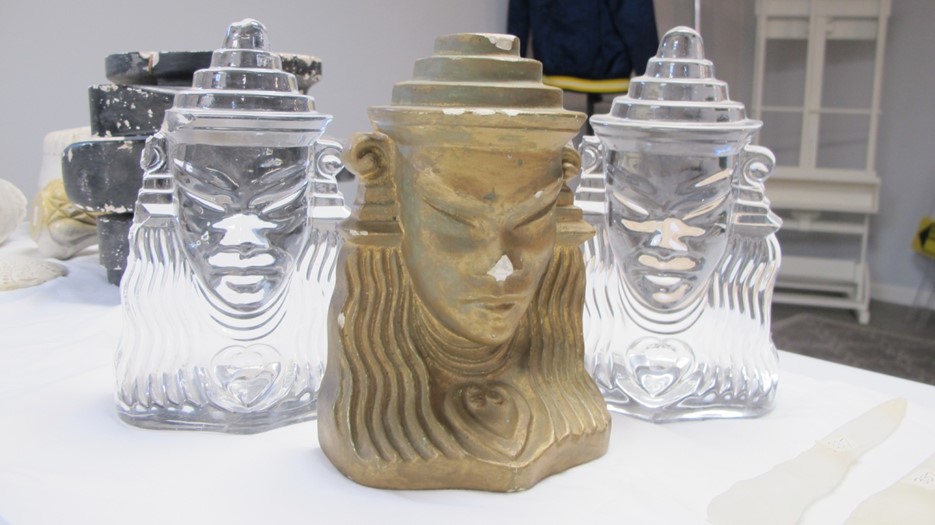
Scroll for additional information
Deco-styled bookends inspired by a post-War focus on Asian culture.
Tiffin Glass introduced its Art Deco-styled model #6320 Burmese bookends in 1952, around the same time that other bookends with Asian motifs were offered by Imperial Glass, through their Cathay line (starting c. 1949), and Roseville Pottery, which produced multiple Burmese headsets in the 1950s. Burma (now Myanmar) gained its independence in 1948 and the nation’s plight was covered in media across the United States. Asian motifs also appeared in American popular culture of the time through works such as the musical The King and I (1951).
The Burmese bookends were eventually released in at least four colors, including the clear crystal shown here. (Other colors included clear frosted, amethyst, and a nearly black “Killarney green.”) While Walter Przybylek did not do as much work for Tiffin as for other companies, much of what he did involved figural pieces such as this, and the cultural aspects of this theme may have appealed to him.
The plaster model from Przybylek’s workshop offers an interesting comparison to the finished Tiffin products. While most of it is clearly identical in nearly every detail, a final distinct layer can be seen in the headpiece of the glass examples. Whether the plaster piece represents an earlier version or an attempt at later simplification is not clear.
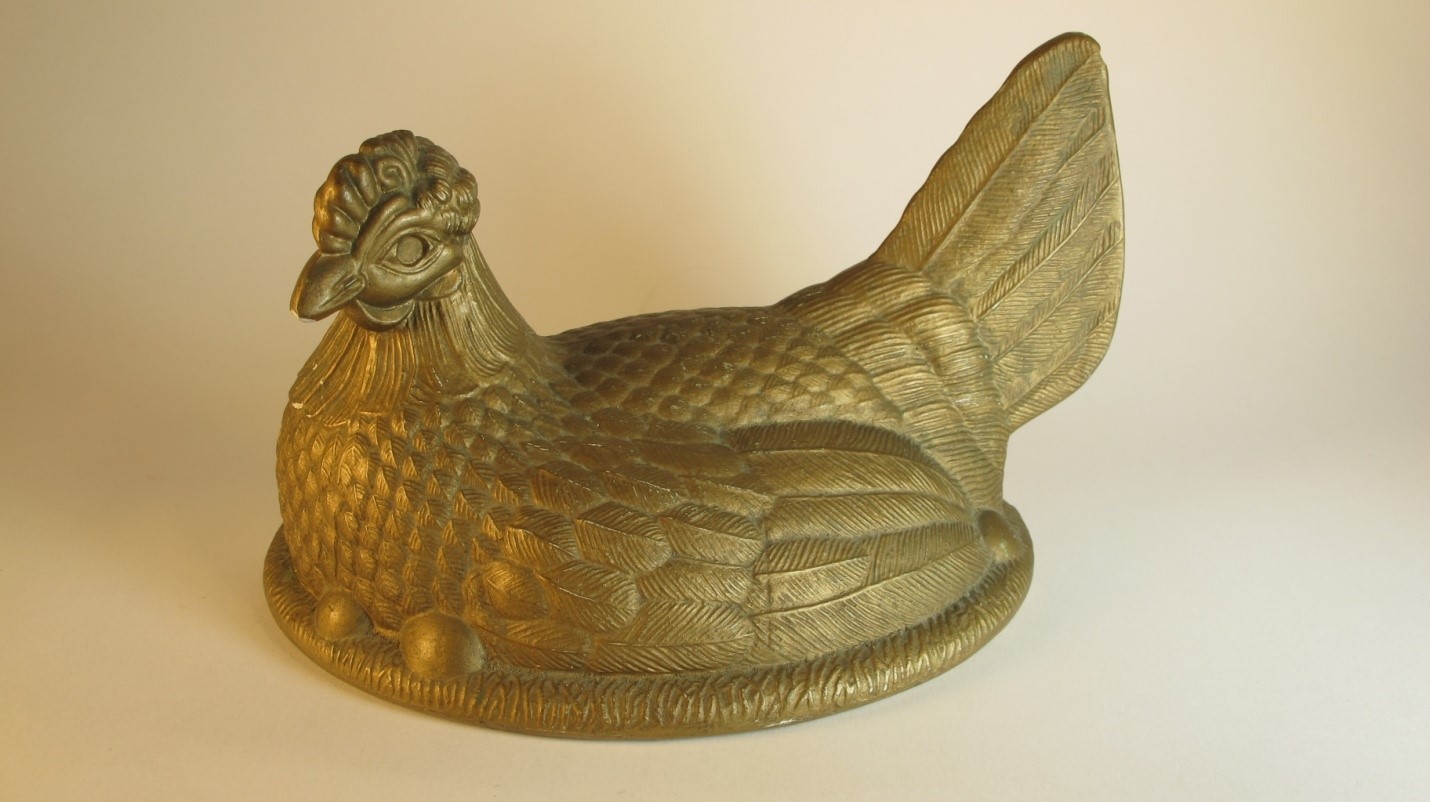
Scroll for additional information
Model used in the mold-making process for a popular covered candy dish.
This well-known hen-on-nest covered candy dish was originally created by Pittsburgh’s Atterbury Glass Company for their celebrated animal dish line that started in the 1880s. After Atterbury closed, many of its molds ended up at the Westmoreland Glass Company, which continued to produce the hen for many years.
Multiple glass companies offered hen-on-nest variations, but the Atterbury design was one of the most detailed, with a pronounced head tilt. Independent piece-mold makers such as Walter Przybylek were often called in to assist with troubleshooting when molds were encountering difficulties or elements needed to be refined. This model may represent a step in that process for a pattern that had been in production for decades.
Details from the hen show the handwork that went into every step of the process. Ultimately plaster models such as this would have been all that remained in Walter’s shop after the finished elements were returned to the glass company that commissioned the pattern or mold work.
This piece has been donated to the collection of the Senator John Heinz History Center in Pittsburgh, Pennsylvania.
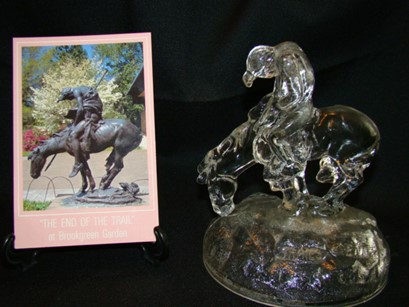
Scroll for additional information
A glass decorative figure based on James Earl Fraser’s statue “The End of the Trail.”
American sculptor James Earl Fraser first created the “End of the Trail” in 1894 when he was just 17. The work became famous after a larger plaster version was made and exhibited at the 1915 Panama-Pacific International Exposition in San Francisco. After the Exposition, Fraser himself issued multiple smaller replicas and larger casts of the work. Over time it ended up appearing on everything from postcards to a Beach Boys album cover, Surf’s Up (1971). Fraser died in 1953, before seeing his original plaster enlargement resurrected at the National Cowboy Hall of Fame in Oklahoma City.
“End of the Trail” became a widely popular motif from the 1920s onward, and it is not surprising that a glass version was tested. The simplified figure depicted here bears a strong resemblance to examples found on cast metal bookends of the period, with the addition of a larger rock base and the altered title. Family oral history identified this as a piece done in conjunction with Ken Haley and the K. R. Haley Glassware Company. While not confirmed, that would fit with other aspects of a product line that included multiple bookends and figural pieces.
The existing example may be the only one of its kind, and no plaster model or mold was found in Walter’s studio. It was clearly not a market-ready copy. Dark spots are visible embedded in the figure and along the bottom of the base.

Scroll for additional information
Plaster busts connected to novelty lamps created for the 1940 Presidential campaign.
In 1940, Democratic President Franklin D Roosevelt was running for an unprecedented third term against Republican challenger Wendell Willkie. At the time, electrification of rural America was in process, aided by FDR’s support for the Tennessee Valley Authority (TVA) and the Rural Electrification Act of 1936. Wilkie, by contrast, had at one point served as a spokesperson for the private electrical power industry. Some unusual campaign promotions took advantage of this growing availability of electricity to promote their candidates. People at the time would have gotten a sense of irony in displaying an illuminated bust of their preferred candidate.
These busts were commissioned in early 1940 after Wilkie became the Republican candidate and were eventually made into frosted glass lamps. (The figures were illuminated via an internal mount in the base with a bulb and cord.) Their origin is uncertain. Walter Przybylek’s son remembered a connection to the Phoenix Glass Company; the FDR Presidential Library attributes the finished example in their collection to the Monaca Novelty Glass Company. Either way, Walter Przybylek was involved with preparing models and preliminary molds for the project, and these busts were recovered from his Westmont Avenue studio. It is unlikely the lamps were produced in large quantities.
Included in the Przybylek collection are original plaster models of both Roosevelt and Willkie, along with a glass version of Roosevelt that a friend gave Jerry Przybylek following a lengthy search for a finished example to complement the models. Family oral history suggested that the original clay sculptures for the busts of Wilkie and Roosevelt were done by Pittsburgh sculptor Myrtle Altwater (active as a sculptor c. 1930 - 1940s), although the bust of Roosevelt has “W. Przybylek” incised into the bottom of it. Przybylek worked with a circle of other artists and craftsmen in the city, and Altwater, whose brother ran a very well-known photographic studio, lived in nearby Beechview.
These pieces have been donated to the collection of the Senator John Heinz History Center in Pittsburgh, Pennsylvania.
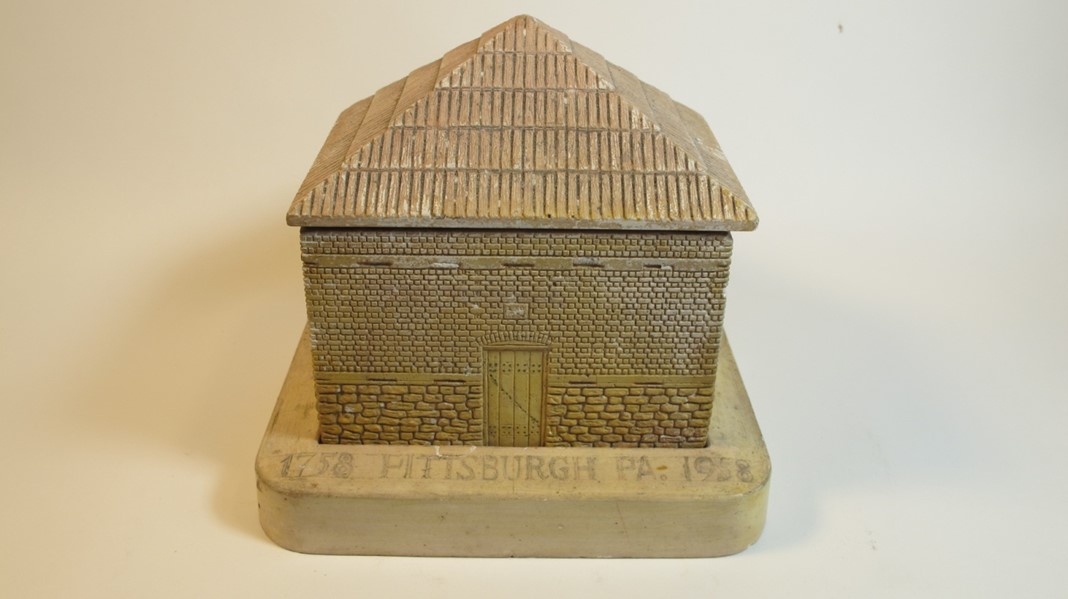
Scroll for additional information
A set of elements for a Fort Pitt Blockhouse model that may never have been put into production.
In the early 1970s, Westmoreland Glass produced a small hollow souvenir container shaped like the Fort Pitt Blockhouse that was based on a previous mold that the company first used in the 1920s. This plaster model and mold set is similar to those, though clearly not an exact match. It is also considerably larger, at least twice the scale of the existing Westmoreland glass miniatures.
This set was found in Walter Przybylek’s workshop after his death, and its connection to any glass models that were actually produced is unknown. Given the pencil notations on the base and the fact that it remained with him, it may have been a job that was canceled or changed in a very preliminary stage, perhaps something related to the city’s Bicentennial in 1958. If it was somehow related to Westmoreland’s reissue in the 1970s, that was very late in Walter’s career and it may not have been completed.
While this model was never put into production, it illustrates the fine detail involved with the creation of such figural pieces, even if just for souvenir purposes. From the stones at the base of the blockhouse to the brick arch over the door, each element has to be included in the model before it can appear in a finished glass item. The four-piece mold with its wedge and dart joints also testifies to its craftsman’s skills.
These pieces have been donated to the collection of the Senator John Heinz History Center in Pittsburgh, Pennsylvania.
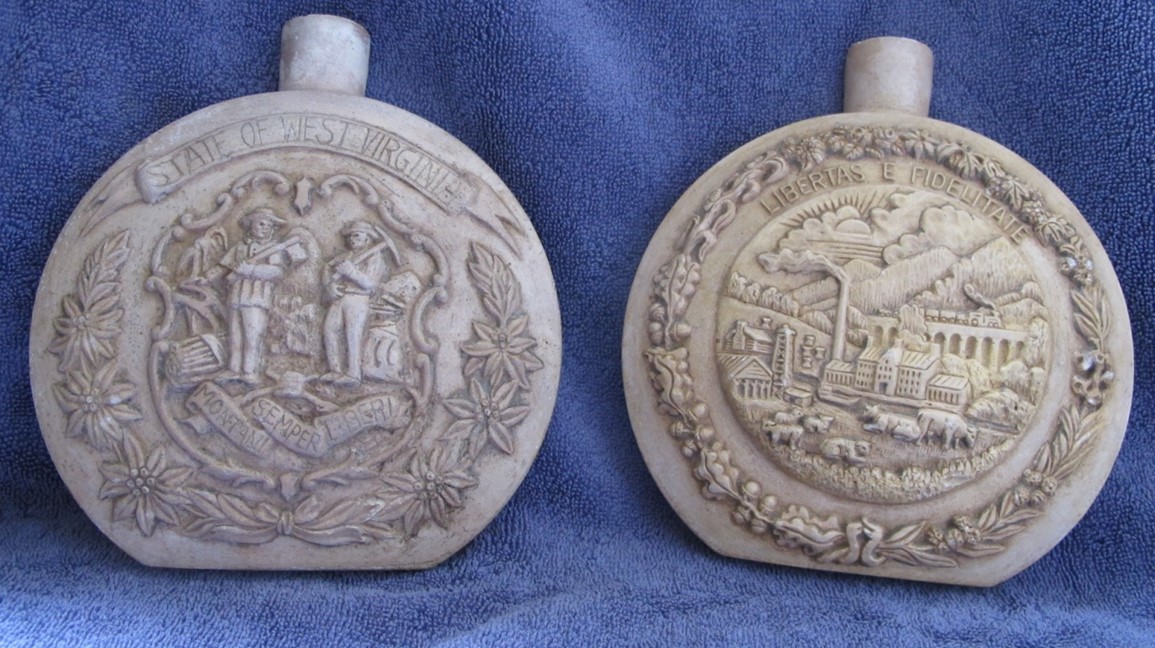
Scroll for additional information
These related bottles were created to represent a West Virginia milestone.
West Virginia, a state with a rich history of glass production, celebrated its centennial in1963. The state commissioned Imperial Glass Company of Bellaire, Ohio to create glass decanters as commemorative souvenirs of the event, to be sold at state sites and official centennial celebration locations. The resulting glass decanters were produced in two colors, clear blue and clear yellow, in a nod to the colors of the West Virginia state flag. Later, the state produced almost identical designs to be used as souvenirs for the West Virginia Pavilion at the1964 World’s Fair in New York City.
Imperial Glass probably hired Walter Przybylek to create the models and pattern molds for these decanters. The collection includes plaster half-models of the state seal and of a combined rural and industrial landscape. On the back of one of the plaster halves there are pencil notations related to Walter’s work process. These could have been general foundry notes, or might have been instructions for Jerry, who had begun helping his father with some jobs in the shop.
The collection includes two bottles. The clear blue glass decanter displays the state seal on one side and an outline of West Virginia on the other. This is a bottle from the Centennial celebration, with the words “Made by Imperial Glass” on its base. The clear yellow decanter features the landscape on one side and the West Virginia state seal on the other. This example was offered at the World’s Fair. Its base reads: “WV Pavilion, 1964 - 1965."
These pieces have been donated to the collection of the Senator John Heinz History Center in Pittsburgh, Pennsylvania.
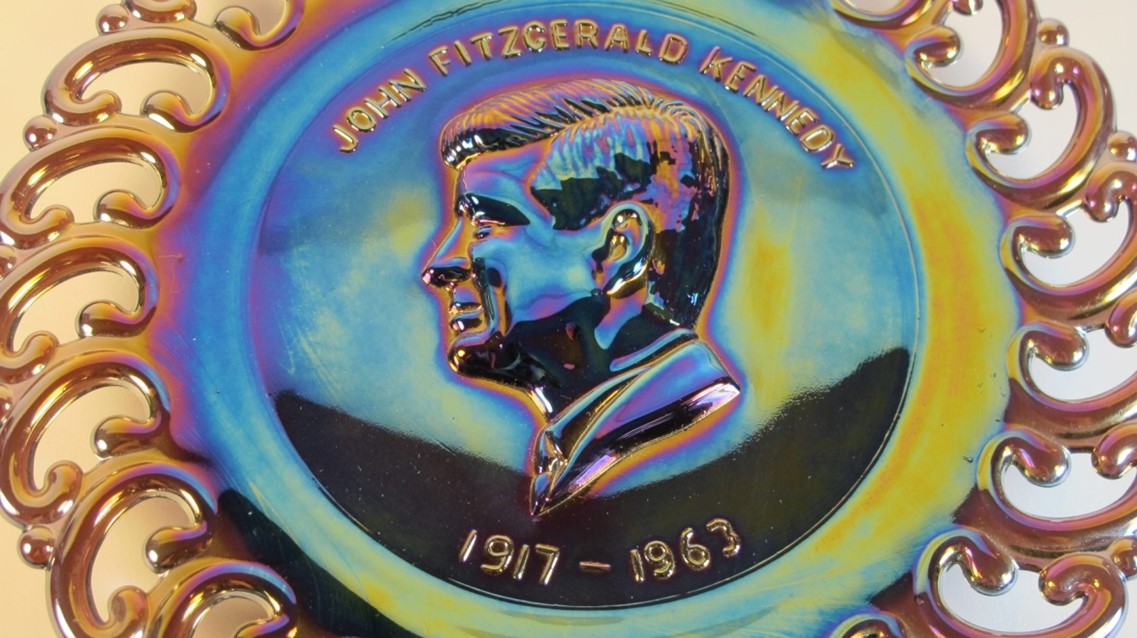
Scroll for additional information
These commemorative plates from L. E. Smith Glass Company began appearing in 1971, towards the end of Walter Przybylek’s career.
L. E. Smith Glass Company issued a series of these commemorative plates with open-edge scrolls featuring historical figures, starting with John F. Kennedy and Abraham Lincoln in an edition of 2500 in July 1971. Eventually more were issued, including Robert E. Lee and Jefferson Davis (which did not prove quite as popular but may have been inspired by earlier bottles issued by the company in 1961 in commemoration of the Centennial of the American Civil War.) The plates came in several colors, including clear blue, amber, and milk glass white.
This deep amethyst plate may have been a first advance or test pressing of the wider limited edition. This assessment is based on the inscription etched into the upper back edge of the plate: “THE SIXTH OF ONLY 745 KENNEDY PLATES PRESSED JANUARY 1971 MT PLEASANT PA.”
Walter Przybylek’s career was winding down by the time L. E. Smith Glass commissioned this project, c. 1969-1970 (He passed away in 1977.) Suffering from Parkinson’s and other health conditions, he sometimes worked with his son Gerard (an art school graduate) to develop the drawings for such late-stage projects, and the designs and models for the Kennedy plate were examples of such a collaboration.
These pieces have been donated to the collection of the Senator John Heinz History Center in Pittsburgh, Pennsylvania.
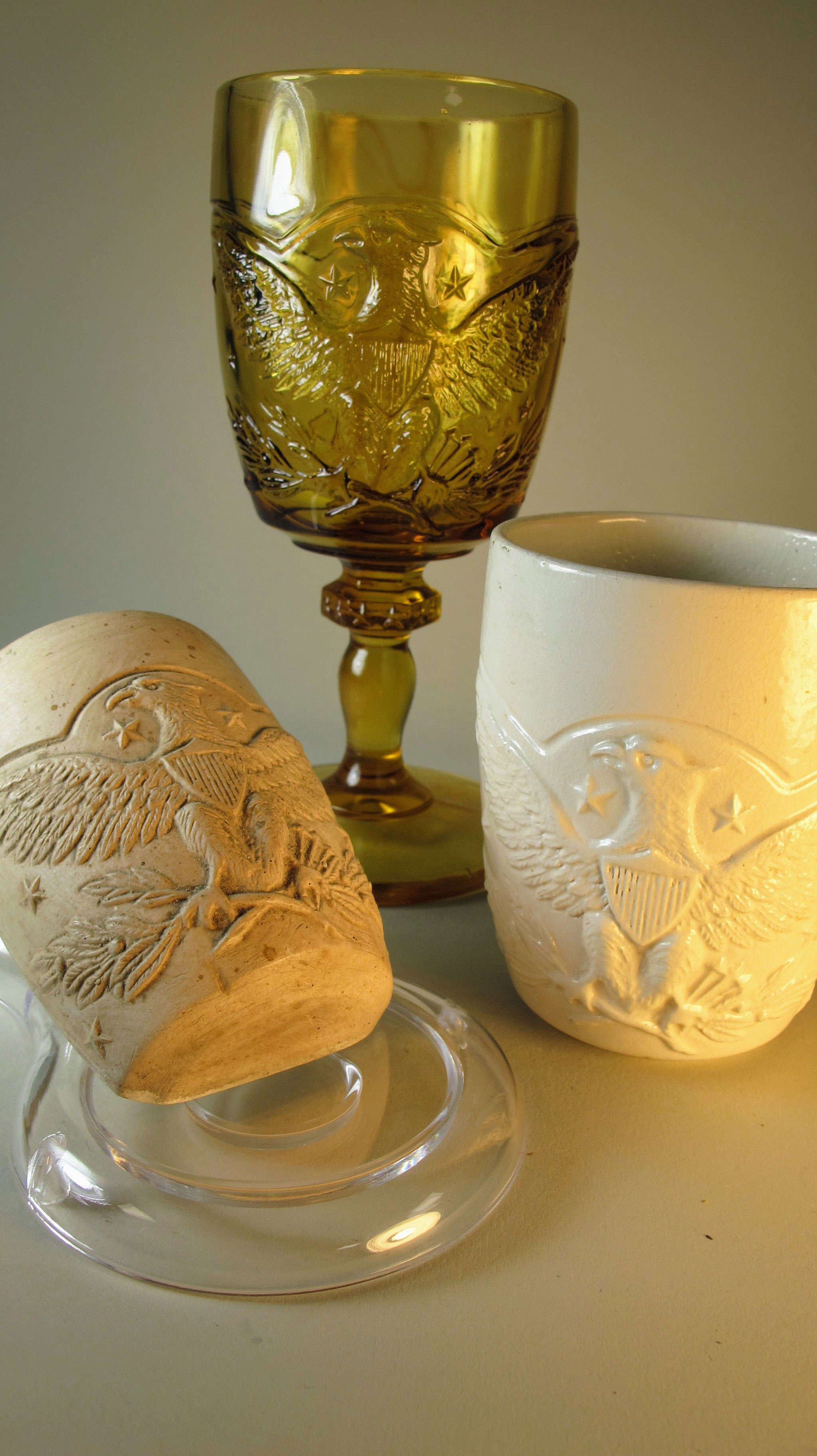
Scroll for additional information
These examples demonstrate the customization of a pattern to the shape of a glass.
Introduced in the early 1960s, L. E. Smith’s Federal Eagle or Eagle pattern featured this patriotic eagle and stars motif on multiple forms, including a lidded candy jar, covered compote, small bowl, and a wine or water glass. Primarily produced through the early 1970s, it was issued in multiple colors and milk glass. A later iridescent carnival glass line using the same motif was offered in connection with the U.S. Bicentennial in 1976.
This pattern offers a good example of how glass companies required ongoing work and coordination with pattern and mold makers to customize an established pattern to the specific form and production needs of multiple shapes within a larger product line.
Two plaster sides and a whole model for the Federal Eagle found in Walter Przybylek’s studio demonstrate his work shaping and refining this motif specifically into the shape of a water or wine goblet.
These pieces have been donated to the collection of the Senator John Heinz History Center in Pittsburgh, Pennsylvania.